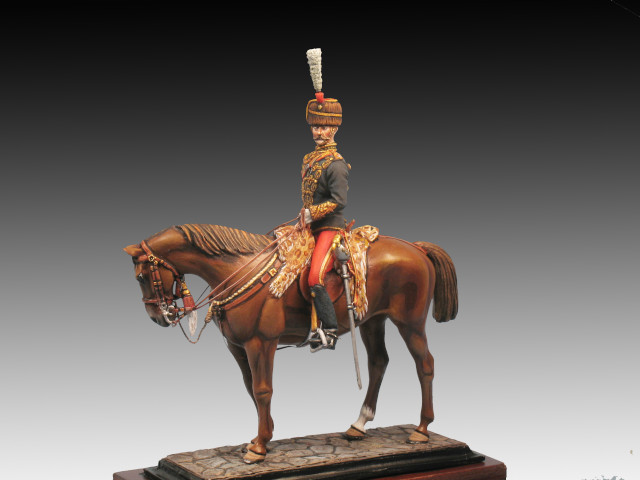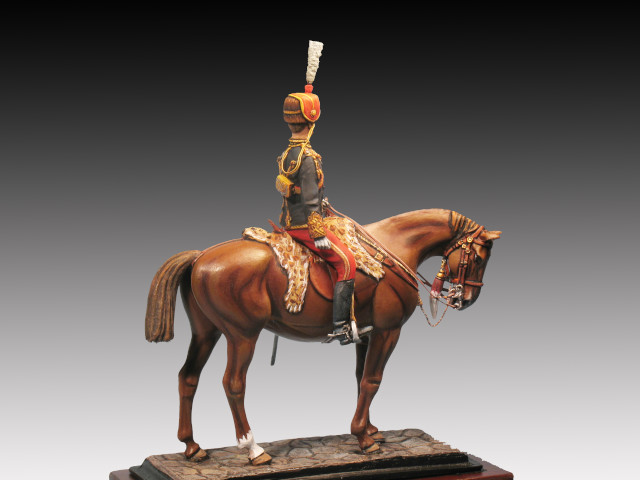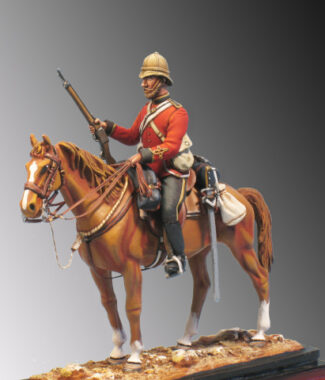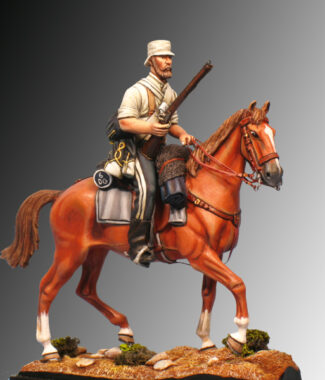You must be logged in to post a review.
11th (Or Prince Albert’s Own) Hussars – 1889
€68.00
Figure to assemble and paint
Ref.: 10 – CRV
Weight: 170 grs.
Material: White Metal
Number of Pieces: 19
Historical Review:
Raised in 1715 as Honeywood’s Regiment of Dragoons
1751 – 11th Regiment of Dragoons
1783 – 11th Regiment of Light Draggons
1840 – 11th (Prince Albert’s Own) Hussars
1861 – 11th (or Prince Albert’s Own) Hussars
1921 – 11th Hussars (Prince Albert’s Own)
1969 – Regiment amalgamated with 10th Royal Hussars (Prince Albert’s Own) to form The Royal Hussars (Prince of Wales’s Own)
Battle Honours:
Early wars: Warburg, Beaumont, Willems, Egypt, Salamanca, Peninsula, Waterloo, Bhurtpore, Alma, Balaklava, Inkerman, Sevastopol 1854.
The Great War (1914-1918): Mons, Le Cateau, Retreat from Mons, Marne 1914, Aisne 1914, Messines 1914, Armentières 1914, Ypres 1914-15, Somme 1916-18, Flers-Courcelette, Arras 1917, Scarpe 1917, Cambrai 1917-18, St. Quentin, Rosières, Amiens, Albert 1918, Hindenburg Line, St. Quentin Canal, Beaurevoir, Selle, France and Flanders 1914–18.
The Second World War: Egyptian Frontier 1940, Withdrawal to Matruh, Capture of Tobruk, Beda Fomm, Halfaya 1941, Sidi Suleiman, Tobruk 1941, Saunnu, Msus, Defence of Alamein Line, Alam el Halfa, El Alamein, Advance on Tripoli, Tunis, North Africa 1940–43, Capture of Naples, Volturno Crossing, Italy 1943, Roer, Rhine, Ibbenburen, Aller, North-West Europe 1944–45.
Once the regiment was raised, it took an active part in the Jacobite Rebellion and 30 years later in the second Rebellion until the Battle of Culloden (1746). He took part in the Seven Years’ War (1756-63), first in France and then fighting in Germany in Warburg (1760) and Villinghausen (1761).
In 1793, it sent two squadrons to fight in France and the Low Countries, serving at Famars and Valenciennes. It returned to Europe in 1799, fighting at Alkmaar
It fought in the Peninsular War from 1811 to 1813, including at Badajoz and Salamanca (1812), before deploying to Belgium in 1815, capturing the last French guns still firing at Waterloo (1815). It then joined the Army of Occupation in Paris.
In 1819, it set off for its first Indian posting, during which it was involved at the Siege of Bhurtpore in the Jat War (1825-26). This lasted until 1838 and left all but 224 men of the regiment unfit for service
The regiment served in the Crimean War (1854-56), where it fought at Alma (1854) and participated in the Charge of the Light Brigade at Balaklava (1854), losing five officers and 55 men.
He spent much of the rest of the century in England and Ireland. This was interrupted by two further deployments to India, from 1866 to 1878 and 1890 to 1899, and garrison duties in South Africa and Egypt.
In August 1914, it joined the British Expeditionary Force, remaining on the Western Front throughout the First World War (1914-18) in both a mounted and dismounted role. Its engagements included Mons and Nery in 1914 and Ypres in 1915.
In the 1920s, it garrisoned Egypt and India and, in 1928, became one of the first British cavalry units to mechanise. The regiment then deployed to Egypt and Palestine for much of the 1930s, manning the border with Italian Cyrenaica during the Abyssinian crisis and suppressing the Arab Revolt.
It fought in the Western Desert during the early years of the Second World War (1939-45), where its engagements included Beda Fomm (1941) and the Second Battle of El Alamein (1942). It later moved on to Italy in 1943 and NorthWest Europe from June 1944 to the war’s end.
It remained on occupation duty in Germany until 1953, when it was deployed in the Malayan Emergency (1948-60). It served in Northern Ireland in 1959 and sent two squadrons to Aden in 1960. The last full-unit deployment for the regiment was seven years in Germany from 1962. At the end of this, it returned to England to merge with the 10th (Prince of Wales) Royal Hussars, forming The Royal Hussars (Prince of Wales).








Reviews
There are no reviews yet.